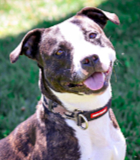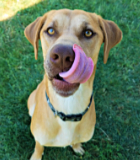Introducing a New Puppy or Dog to the Resident Dog
- This topic has 0 replies, 1 voice, and was last updated 16 years, 4 months ago by
Mackenzie’s Admin.
-
AuthorPosts
-
January 23, 2009 at 3:01 am #331
Mackenzie’s Admin
MemberDogs are social animals and most enjoy the company of other dogs. However, it can be tricky to introduce a new puppy or dog into the family. The resident dog may not be accustomed to having other dogs in his home or he may not appreciate having to share your attention. First impressions are important, so you’ll need to do what you can to maximize the chances of success.
If your dog has a history of fighting with other dogs, please consult with a Certified Applied Animal Behaviorist, Veterinary Behaviorist, or Certified Professional Dog Trainer before introducing the new dog.
Preparation
Before you bring the new puppy or dog home, remove anything your resident dog might guard, such as food bowls, bones, chew toys, toys, and beds. Even if your dog has never exhibited possessive tendencies before, it is best to exercise caution. If your home is cluttered, clean it up. Congested areas are more likely to trigger aggression because the dogs may feel forced upon each other.The Initial Meeting: Before You Bring the New Dog Home
Enlist the help of a family member or friend, so there is a person to attend to each dog during this initial meeting. Make your way, separately, to a neutral area, such as a park. An open area in the park is perfect because there are plenty of interesting sights and sounds to distract the dogs and they can move away from each other if they choose. It is best not to introduce the dogs in your house or yard because the resident dog may become territorial.Bring the dogs together and allow them to greet each other. Do your best to keep slack in the leashes (or let the leashes drop) so the dogs won’t feel like they are being held back. Allow them to sniff. A puppy will typically adopt a submissive position, such as lying down or even rolling over to be investigated by the adult dog. A well-socialized adult dog will likely check out the puppy and then either play with him or ignore him. When two adult dogs meet, they often stand tall and “posture” to each other. They may sniff each other, circle each other, urinate, play, or just decide to ignore each other. Don’t panic if they push each other a bit, growl, or even try standing up on each other’s shoulders. Allow them to do what they do to establish a relationship, with as little intervention from you as possible.
If the dogs try to fight, however, you will need to intervene. If you see signs of serious tension, such as raised hackles, growling, showing teeth, prolonged stares, or snapping, call the dogs away before things escalate. Try not to pull them away by the leash, as the tension on the leash might trigger an attack. If the dogs won’t come away on their own, wave a treat in front of each dog’s nose and then lure them to turn away from each other.
Keep the interactions brief at first. After the dogs greet, go for a walk together. If you have multiple dogs, introduce each dog to the newcomer separately before bringing everyone together as a group.
Bringing the New Dog Home
Walk home from the park with the dogs together and just walk into your home as though nothing has changed. If you have a yard, go there first and let the dogs off leash to hang out while you supervise. When the dogs are ready, bring them into the house. If they got along well at the park and in the yard, let the resident dog off the leash first. Permit the new puppy or dog to explore the room or house on the leash. If the resident dog acts in a friendly manner, let the new pet off the leash.Always supervise interactions between the dogs until they have been friendly with each other for one to two weeks. They should not be alone together before them. Keep your mealtime, bedtime, walk and play routines the same as before the new dog arrived, so things don’t seem too different for the resident dog.
For the first few weeks, keep an eye on the dogs in situations that might trigger aggression, such as when you come home, when guests come over, going out to the yard, coming in from the yard, preparing to go for a walk, mealtime (theirs and yours), and playtime.
It is very important that you spend time with each dog alone so that the resident dog continues to receive one-on-one attention and the new dog develops a bond with you. If you only hang out with the dogs together, they will become attached primarily to each other, rather than to you. The new dog needs to bond with you.
What not to do:
– Do not hold the puppy in your arms for the adult dog to greet. This may cause the puppy to feel trapped and threatened. Instead, stand with your feet slightly apart so the puppy can take refuge between your feet if he feels overwhelmed. Do not permit the older dog to trample, bowl over, or otherwise intimidate the puppy.
– Do not put the dogs in small spaces together, such as a car, crate or small room, before they are completely comfortable with each other. Each dog should have his or her own food bowl, bed, and toys. Place the food bowls far apart until the dogs are relaxed when eating together. Do not allow one dog to intimidate the other so that one dog abandons his food. Teach each dog to eat from his own bowl and leave the other bowls alone, even after everyone is finished.
– If a fight breaks out, DO NOT let them “fight it out.” You may have heard this popular advice, but permitting the dogs to continue a fight can set the tone for a difficult relationship. Interrupt and separate the dogs if they begin to fight or if one dog beats up on the other dog. It is always better to interrupt fighting so the dogs do not develop a pattern of aggressive behavior.How should fighting dogs be separated?
Get the dogs apart however you can, while doing your best to not be bitten in the process. It is quite common for owners to be bitten breaking up a fight, often by their own dog. Your first action should be to shriek and yell—this works with many dogs. If the dogs are on leash, pull them apart but be aware that you may inadvertently cause the dogs to injure each other as some tend to clamp down with their jaws to resist the pull. If the dogs are off leash, try getting behind one, grabbing him by the body, and lifting him off the ground. Sometimes, the feeling of being airborne causes the dog to stop fighting. Be very careful because this strategy places you in a vulnerable position! If you can’t grab them, try grasping the aggressor by the tail, ear, or testicles. Pinch hard to encourage the dog to turn away from his opponent and toward you, but be ready to jump back if the dog turns to bite you. If one dog is locked onto the other, you may need to pry the dog’s jaws open with your hands or with a stick. Another option is to use your fingers to temporarily cut off the dog’s breath by placing pressure against his windpipe. Spraying the dogs with a water hose or blasting them with an air horn or Direct Stop citronella spray can also be effective. -
AuthorPosts
- You must be logged in to reply to this topic.












































